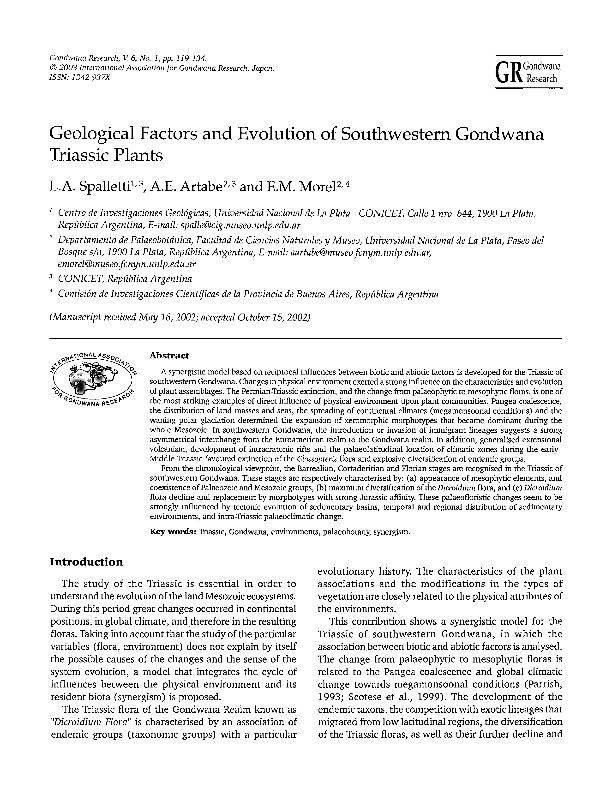Mostrar el registro sencillo del ítem
dc.contributor.author
Spalletti, Luis Antonio

dc.contributor.author
Artabe, Analia Emilia Eva

dc.contributor.author
Morel, Eduardo Manuel

dc.date.available
2019-03-26T19:57:44Z
dc.date.issued
2003-03
dc.identifier.citation
Spalletti, Luis Antonio; Artabe, Analia Emilia Eva; Morel, Eduardo Manuel; Geological factors and evolution of southwestern Gondwana Triassic plants; Elsevier Science; Gondwana Research; 6; 1; 3-2003; 119-134
dc.identifier.issn
1342-937X
dc.identifier.uri
http://hdl.handle.net/11336/72579
dc.description.abstract
A synergistic model based on reciprocal influences between biotic and abiotic factors is developed for the Triassic of southwestern Gondwana. Changes in physical environment exerted a strong influence on the characteristics and evolution of plant assemblages. The Permian-Triassic extinction, and the change from palaeophytic to mesophytic floras, is one of the most striking examples of direct influence of physical environment upon plant communities. Pangea coalescence, the distribution of land masses and seas, the spreading of continental climates (megamonsoonal conditions) and the waning polar glaciation determined the expansion of xeromorphic morphotypes that became dominant during the whole Mesozoic. In southwestern Gondwana, the introduction or invasion of immigrant lineages suggests a strong asymmetrical interchange from the Euroamerican realm to the Gondwana realm. In addition, generalised extensional volcanism, development of intracratonic rifts and the palaeolatitudinal location of climatic zones during the early-Middle Triassic favoured extinction of the Glossopteris flora and explosive diversification of endemic groups. From the chronological viewpoint, the Barrealian, Cortaderitian and Florian stages are recognised in the Triassic of southwestern Gondwana. These stages are respectively characterised by: (a) appearance of mesophytic elements, and coexistence of Palaeozoic and Mesozoic groups, (b) maximum diversification of the Dicroidium flora, and (c) Dicroidium flora decline and replacement by morphotypes with strong Jurassic affinity. These palaeofloristic changes seem to be strongly influenced by tectonic evolution of sedimentary basins, temporal and regional distribution of sedimentary environments, and intra-Triassic palaeoclimatic change.
dc.format
application/pdf
dc.language.iso
eng
dc.publisher
Elsevier Science

dc.rights
info:eu-repo/semantics/openAccess
dc.rights.uri
https://creativecommons.org/licenses/by-nc-sa/2.5/ar/
dc.subject
Environments
dc.subject
Gondwana
dc.subject
Palaeobotany
dc.subject
Synergism
dc.subject
Triassic
dc.subject.classification
Meteorología y Ciencias Atmosféricas

dc.subject.classification
Ciencias de la Tierra y relacionadas con el Medio Ambiente

dc.subject.classification
CIENCIAS NATURALES Y EXACTAS

dc.title
Geological factors and evolution of southwestern Gondwana Triassic plants
dc.type
info:eu-repo/semantics/article
dc.type
info:ar-repo/semantics/artículo
dc.type
info:eu-repo/semantics/publishedVersion
dc.date.updated
2019-03-18T14:44:27Z
dc.journal.volume
6
dc.journal.number
1
dc.journal.pagination
119-134
dc.journal.pais
Países Bajos

dc.journal.ciudad
Amsterdam
dc.description.fil
Fil: Spalletti, Luis Antonio. Consejo Nacional de Investigaciones Científicas y Técnicas. Centro Científico Tecnológico Conicet - La Plata. Centro de Investigaciones Geológicas. Universidad Nacional de La Plata. Facultad de Ciencias Naturales y Museo. Centro de Investigaciones Geológicas; Argentina
dc.description.fil
Fil: Artabe, Analia Emilia Eva. Consejo Nacional de Investigaciones Científicas y Técnicas; Argentina. Universidad Nacional de La Plata. Facultad de Ciencias Naturales y Museo; Argentina
dc.description.fil
Fil: Morel, Eduardo Manuel. Provincia de Buenos Aires. Gobernación. Comisión de Investigaciones Científicas; Argentina. Universidad Nacional de La Plata. Facultad de Ciencias Naturales y Museo; Argentina
dc.journal.title
Gondwana Research

dc.relation.alternativeid
info:eu-repo/semantics/altIdentifier/url/https://www.sciencedirect.com/science/article/pii/S1342937X05706481
dc.relation.alternativeid
info:eu-repo/semantics/altIdentifier/doi/https://doi.org/10.1016/S1342-937X(05)70648-1
Archivos asociados
